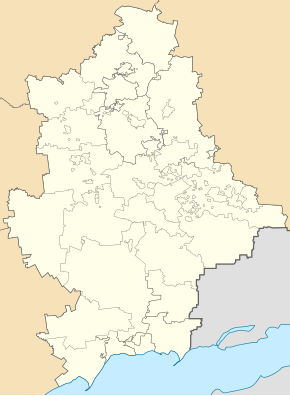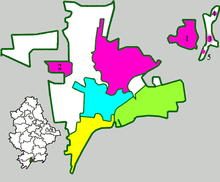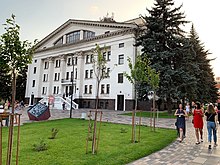Mariupol
| Mariupol | ||
| Маріуполь | ||

|
|
|
| Basic data | ||
|---|---|---|
| Oblast : | Donetsk Oblast | |
| Rajon : | District-free city | |
| Height : | 22 m | |
| Area : | 203.96 km² | |
| Residents : | 444,493 (2018) | |
| Population density : | 2,179 inhabitants per km² | |
| Postcodes : | 87500 | |
| Area code : | +380 629 | |
| Geographic location : | 47 ° 6 ' N , 37 ° 33' E | |
| KOATUU : | 1412300000 | |
| Administrative structure : | four city rajons , three urban-type settlements , one village, one settlement | |
| Mayor : | Vadym Boichenko | |
| Address: | пр. Леніна 70 87 500 м. Маріуполь |
|
| Website : | www.marsovet.org.ua | |
| Statistical information | ||
|
|
||
Mariupol ( Ukrainian Маріуполь ; Russian Мариуполь ) is a city in the Donetsk Oblast in Ukraine with around 440,000 inhabitants (as of 2018). The city was historically one of the most important centers of the Greeks in Ukraine , who to this day are an important minority in the city. Mariupol is located on the shores of the Sea of Azov at the mouth of the Kalmius and is an important port, university town and economic center. About 9 km west of the city is a civil airport with a runway of 2570 m.
Administrative structure
Mariupol is divided into the four urban districts of Central Raion (until January 28, 2016 Shovtnewe Raion ), Kalmius Raion , Liwobereschna Raion and Prymorske Raion, with Kalmius Raion being divided into the three urban-type settlements Sartana , Staryj Krym and Talakivka , the village of Hnutowe ( Гнутове ) and the settlement Lomakyne ( Ломакине ) is divided.
At the end of 2014, parts of Novoasovsk Rajon, which was occupied by the war in Ukraine, were added. These are the villages of Prymorske , Wynohradne and Pionerske , the area of the urban area is thus 203.96 square kilometers in 2015.
history
The city was founded in 1789 and has long been a center of Pontic Greek culture, until the late 19th century the majority of the city's population were of Greek origin. The current name of the city is also of Greek origin ( Greek Μαριούπολη / Mariúpoli ; "City of Mary"). The city is also home to the famous painter Archip Kuindschi . In the 19th century, the city was the administrative center of Ujesd Mariupol in the Yekaterinoslav governorate . The Mariupol tram, which opened in 1933, still runs today.
After the German invasion of the Soviet Union on June 22, 1941, the city was occupied by Wehrmacht troops between October 8, 1941 and September 10, 1943 . The city suffered severe destruction, a large part of the city's Jewish community, around 11% of the population in 1926, fell victim to the Holocaust . At the beginning of the occupation there were around 241,000 inhabitants, at the end of 1943 only 85,000 people lived in the city. Many Mariupolians were deported to Germany for forced labor in 1942 and did not return until 1945. From 1942 Mariupol was a main area of operation for Soviet partisans.
After the Second World War , a rapid reconstruction took place, just a few years after the war the population of Mariupol reached the pre-war level and rose to well over half a million people by 1989. Numerous industrial companies were settled in the city and the port facilities expanded. Between 1948 and 1989 the city of birth of the Soviet functionary Andrei Zhdanov was named in his honor Zhdanov (Russian Жданов ).
Since 1991 the city has belonged to the independent Ukraine . Since then, Mariupol, like numerous other cities in Ukraine and other post-Soviet states, has struggled with structural change and associated problems, especially a decline in population.
In March 2014, a pro-Russian demonstration called for a meeting of the city council to discuss a referendum modeled on the Crimea . From May to June 2014 the fight for Mariupol took place between the Ukrainian military and the people's militias . One of the decisive factors was the change of side of the local oligarchs, "terrified by the lawlessness". According to activists, the conflict made the people in Mariupol differentiate between the unloved state power in Kiev and their homeland: “Politicians can be voted out without changing country.” On January 24, 2015, pro-Russian rebels launched an offensive with a rocket attack According to the Ukrainian authorities, at least 30 people died and 97 were injured. In response, the Azov regiment started a counter-offensive, where further attacks on civilian targets were to be prevented or at least made more difficult by taking the appropriate tactical positions in the village of Schyrokyne and the area northeast of Mariupol. This tactical goal was achieved by taking the village.
economy
Mariupol is a major industrial center and international seaport on the Sea of Azov ; the city is one of the most important economic centers in Ukraine. The metallurgy combines located here (including Azovstal and Illich Iron & Steel Works ) make an important contribution to the country's export goods. Both are part of the Metinvest group, owned by billionaire Rinat Akhmetov . The Azovmash mechanical engineering company is also one of the major employers . The commercial port is also important. There is also a solar industry here on a smaller scale.
Shipping suffered massive damage from economic upheavals due to the imminent war in Donbass and the opening of the Crimean Bridge and Russian harassment with long waiting times in Kerch; in the port of Mariupol, sales halved from 2013 to 2018 and planned expansions became obsolete, according to the director of the port of Mariupol, these economic effects were intended by Russia. Apart from custom-made products, the steelworks could hardly deliver any more goods such as railroad tracks to Russia and had reduced capacity by 40 percent since the beginning of the war.
education
There is a Technical University and Mariupol State University in the city. There is also a humanitarian university and several vocational schools.
Culture
The city is home to several music schools, a local history museum, a Kuindji exhibition and a Russian municipal theater. In addition to numerous Orthodox churches, the city also has a mosque that opened in 2007.
Sports
Mariupol is the seat of the Ukrainian football club FK Mariupol , which plays its home games in the Volodymyr Boyko Stadium . The city is also home to the successful BK Azovmash Mariupol basketball club .
population
Population development
| 1979 | 1989 | 2001 | 2005 | 2015 |
|---|---|---|---|---|
| 502,581 | 518.933 | 492.176 | 482.440 | 455.063 |
Source:
Population composition
In 2002 the population was made up as follows:
- Ukrainians 248,683 (48.7%)
- Russians 226,848 (44.4%)
- Greeks 21,923 (4.3%)
- Belarusians 3,858 (0.8%)
- Armenians 1,205 (0.2%)
- Jews 1,176 (0.2%)
- Bulgarians 1,082 (0.2%)
- others: 6,060 (1.2%)
In the 1882 census (14,980 inhabitants) the population distribution was still as follows:
- Greeks (60%)
- Jews (28%)
- Russians (10%)
- Ukrainians (2%)
languages
Almost 90% of the residents of Mariupol stated Russian as their mother tongue in 2001, just under 10% have Ukrainian as their mother tongue. All other languages are below 1%. Yiddish used to be Mariupol's main language alongside Russian. Today it is only spoken by a small minority of Jews. Many Holocaust survivors emigrated to Israel or the United States. Greek is also hardly spoken any more. Historically, the Greeks (see Greek minority in the successor states of the Soviet Union ) made up a large proportion of the population in Mariupol, but gradually became part of the Slavic population. In addition, many remaining Greeks emigrated to Greece after the collapse of the Soviet Union in the 1990s.
In the 1882 census (14,980 inhabitants) the proportion of languages spoken was:
- Greek (52%)
- Russian (35%)
- Yiddish (12%)
- Ukrainian (less than 1%)
sons and daughters of the town
- Rustam Adschi (* 1973), wrestler
- Sergei Baltatscha (* 1958), Soviet football player
- Wiktor Barjachtar (1930–2020), physicist and university professor
- Nikki Benz (* 1981), model, film director and porn actress
- Olha Bereznjewa (* 1985), swimmer
- Valery Alexeyevich Bossenko (1927–2007), philosopher
- Anatoly Gavrilow (* 1946), writer
- Alexander Gurow (* 1971), professional boxer
- Diana Hacıyeva (* 1989), Azerbaijani singer-songwriter and composer
- Oleksandr Jaroslawskyj (* 1959), entrepreneur, patron and sports official
- Hrihorij Kamyshenko (* 1972), wrestler
- Borys Kolesnikow (* 1962), entrepreneur and politician
- Felix Krivin (1928–2016), Russian, Ukrainian and Israeli writer and children's book author
- Archip Kuindschi (1841–1910), Russian painter of the Peredwischniki
- Oleh Kyrjuchin (* 1975), boxer
- Dmytro Lysenko (* 1981), water diver
- Alexander Pawlowitsch Mogilewskij (1885–1980), painter
- Pavlos Nirvanas (1866–1937), Greek writer
- Vyacheslav Olijnyk (* 1966), wrestler
- Ivan Ostoslawski (1904–1972), Russian aerodynamicist and university professor
- Olexandr Radchenko (* 1976), football player
- Dmitri Sablin (* 1968), Russian politician
- Alexander Sacharoff (1886–1963), painter, dancer and choreographer
- Ivan Timofejewitsch Sawenkow (1846–1914), physics teacher, archaeologist and chess player
- Andrei Zhdanov (1896–1948), Soviet politician and close collaborator of Stalin
- Olexandr Sidorenko (* 1960), Soviet swimmer
- Georgi Tschelpanow (1862–1936), Russian psychologist, logician and philosopher
- Viktor Tschukarin (1921–1984), Soviet gymnast
- Sjarhej Wojchanka (1955–2004), Belarusian artist and designer
- Anna Zatonskih (* 1978), Ukrainian-American chess player
Consulates
There is a Greek and a Cypriot consulate general in Mariupol .
literature
- Grunau and the Mariupol colonies. Row: Georg Leibbrandt Collection , 4th editor Jacob Stach. Materials on the history of German settlements in the Black Sea region, 7th ed. Emil Meynen . S. Hirzel , Leipzig undated (1942)
Varia
In the novel-like biography She came from Mariupol by Natascha Wodin , published in 2017, the city - as the book title suggests - plays an important role.
Web links
Individual evidence
- ↑ a b Population figures on pop-stat.mashke.org.
- ↑ http://marsovet.org.ua/news/show/id/11474
- ↑ Верховна Рада України; Постанова від 12.11.2014 № 32-VIII Про зміни в адміністративно-територіальному устрої Донецької області, зміну і встановлення меж міста Маріуполь, Волноваського, Новоазовського та Тельманівського районів Донецької області
- ↑ Верховна Рада України; Постанова від 20.05.2015 № 457 VIII-Про внесення змін до Постанови Верховної Ради України від 11 грудня 2014 року № 32-VIII "Про зміни в адміністративно-територіальному устрої Донецької області, зміну і встановлення меж Волноваського, Новоазовського та Тельманівського районів Донецької області"
- ↑ Protesters in Mariupol pushed into the city council , website of the city of Mariupol on March 18, 2014.
- ↑ a b c The Ukrainian ports in the Sea of Azov are stuck in the Russian stranglehold , NZZ, November 24, 2018
- ↑ Pro-Russian rebels launch offensive on Mariupol , on de.nachrichten.yahoo, accessed on January 24, 2015.
- ^ "Azov Battalion spearheads Ukrainian counter-offensive" Kyiv Post, accessed June 15, 2015.
- ↑ Pryazovskyi State Technical University (PSTU) .
- ↑ http://history.org.ua/LiberUA/NatsSklRMDonObl/NatsSklRMDonObl.pdf
-
↑ The data from the census of December 5, 2001 on MARIUPOL are listed under Donetska Oblast: Distribution of the population by native language, Donetska oblast on the website of gov.ua - Database Census - Main Regional Statistical Office. The statistics cannot be accessed directly via a link. The following selections must be made on the link provided:
- 1. Select region.
- 2. Select Year
- 3. Select indicated as a native language
- 4. Click on Continue
- The following result should appear:
- MARIUPOL (miskrada)
- 2001 (05/12)
- 9.87 Ukrainian
- 89.53 Russian
- m. MARIUPOL
- 2001 (05/12)
- 10.10 Ukrainian
- 89.39 Russian.
- ↑ In the sense of its namesake, this series served to continually raise German territorial claims to Soviet territories.
- ↑ Information from the publisher's report
- ↑ German National Library











